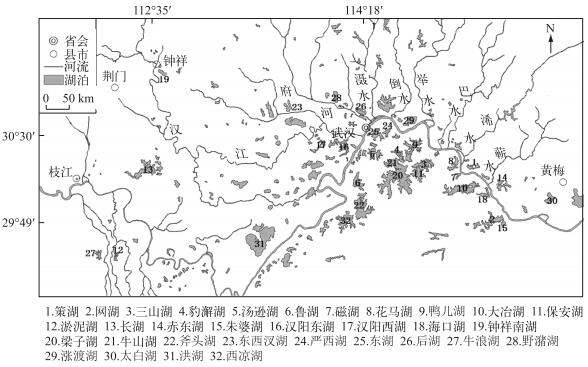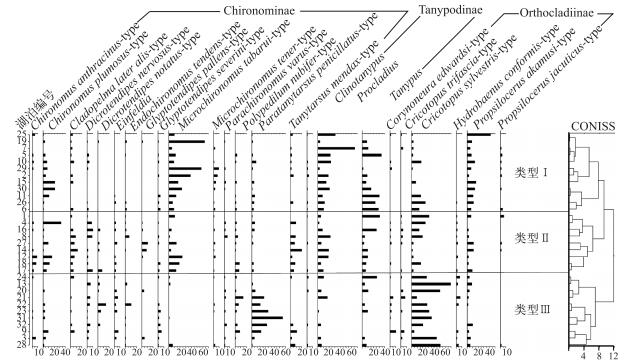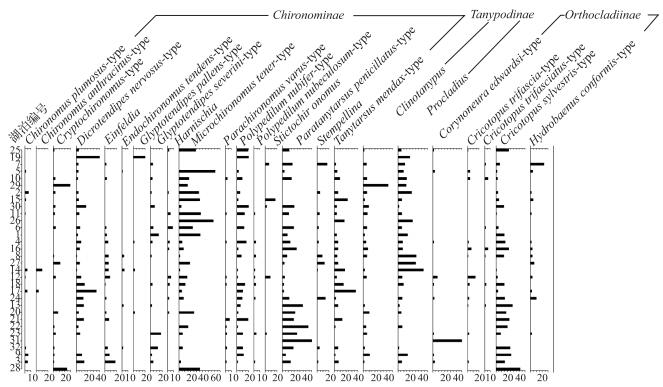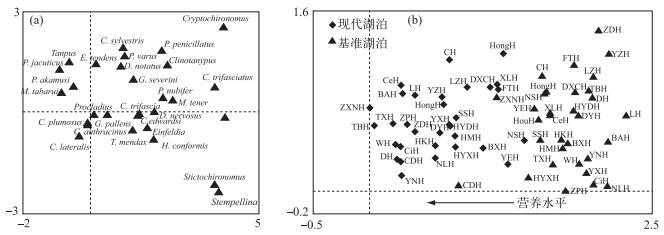(2: 江苏师范大学地理测绘与城乡规划学院, 徐州 221116)
(3: 中南民族大学资源与环境学院, 武汉 430074)
(2: College of Geographical Surveying and Rural-Urban Planning, Jiangsu Normal University, Xuzhou 221116, P. R. China)
(3: College of Resources and Environmental Science, South-Central University for Nationalities, Wuhan 430074, P. R. China)
20世纪以来,湖泊生态系统在强烈的人类活动干扰和全球变暖的影响下[1],发生了一系列前所未有的变化,如湖泊干涸、湖泊生物多样性丧失、入湖营养盐增加导致水质恶化等[2],我国东部湖泊环境污染呈现出严重性、复杂性和全面化的特点,严重影响了流域居民饮用水安全和经济社会可持续发展[3].近年来,针对湖泊污染和生态系统退化问题,国内已开展了大量的生态修复工作,其中一种重要措施就是通过恢复水生植被(特别是沉水植被),培植草型生态系统,以达到改善湖泊水环境的目的[4].科学的湖泊生态修复管理工作,需要了解人类干扰之前的基准环境和湖泊生态系统转变过程.基准环境通常是过去或现在湖泊生态系统未产生(或很少)显著的生态扰动效应下的最佳生态状况[5],欧美国家定义湖泊基准环境最佳时期为工业革命之前(1850s左右)[6],于长江中下游地区湖泊而言,近百年来(尤其是1950s以来)是人类活动最为强烈、湖泊富营养化现象频发的时期,因此湖泊的基准状况时间可选择在1950s之前,即把发生较大变化之前的湖泊生态状况作为基准环境[7-9].
我国湖泊监测工作起步较晚,记录时间短,缺乏长期的湖泊生态系统演化信息[10].古生态技术是目前唯一能够重建过去湖泊环境演变历史和未受干扰前湖泊生态状况的方法,逐渐被国际上推荐为制定湖泊基准环境的主要方法之一[5].目前国内外利用古生态技术制定湖泊基准环境的研究主要集中在硅藻指标[6, 9, 11],随着国内关于摇蚊古生态学研究不断深入,利用摇蚊来制定我国长江中下游浅水湖泊基准环境的目标已能逐步实现[12-13].摇蚊幼虫是地球淡水生态系统中的优势水生昆虫之一,能及时有效响应外界环境变化,其几丁质头壳能够很好的保存在沉积物中,因此常被作为研究湖泊水环境演化的良好生物代用指标[14-15].
本文选择江汉湖泊群作为研究区域,选取32个面积大于10 km2的湖泊作为研究对象(图 1),系统采集了湖泊沉积岩芯,对比分析现代环境(表层)和基准环境(底层)的摇蚊组成和变化.综合以往长江中下游地区湖泊沉积定年、湖泊营养演化历史以及生态系统稳态转换过程的研究,确定江汉湖群沉积岩芯底部49~50 cm的生态状况可作为基准环境[16-18].本文力图首次基于摇蚊亚化石来确定江汉湖泊群基准环境特征,以期为我国长江中下游地区湖泊基准环境的制定和该地区湖泊生态环境的保护及修复提供古生态学基础资料.

|
图 1 江汉湖群地区湖泊采样点分布 Fig.1 Location of sediment cores from Jianghan floodplain lakes |
江汉湖群(29°25′59.25″~31°27′14.45″N, 111°36′38.76″~116°7′52.14″E)位于长江中游地区湖北省境内,属北亚热带季风气候,是我国湖泊分布较为集中和典型的地区之一(图 1).优越的自然条件形成了该区域天然的湖泊生态系统,兼具防洪调蓄、居民供水、渔业养殖、农田灌溉等多种功能,也是水生、湿生植物的重要生境和迁徙水禽极为重要的越冬湿地[19].历史上江汉湖泊群均与长江水道自然连通,由于气候变化、泥沙淤积、构造沉降、河势变化、水土流失和江湖整治工程建设等因素的干扰,江湖连通性正在加速调整,并对区域洪涝灾害防治、水环境保护以及水生态安全维护产生显著影响[20]. 1950s以来,长江流域沿江经济迅速发展,现代化的工业、农业(大量使用化肥)和城镇化导致入湖污染物质浓度急剧增加,随着该流域湖泊富营养化问题日益突显,湖泊生态系统结构和服务功能面临重大挑战[21].
1.2 样品采集和摇蚊头壳提取鉴定2014年使用UWITEC柱状采泥器分别在湖北省32个湖泊(图 1)中心点位采集了长50~60 cm的沉积岩芯,并以2 cm间隔分样,样品密封于7号大小自封袋内,实验室4℃冷藏以待提取摇蚊头壳.
本次研究分别对32根岩芯的1~2、9~10、17~18、25~26、33~34、41~42和49~50 cm 7个样品提取摇蚊头壳,以表层1~2 cm作为现代湖泊环境,底层49~50 cm作为基准环境.摇蚊头壳处理参考Brooks等[22]的标准方法进行,摇蚊幼虫属种的鉴定主要依据文献[22-23].使用TILIA-GRAPH 2.0.b.5软件绘制江汉湖群现代环境和基准环境的摇蚊属种百分比图谱,同时基于现代环境中摇蚊属种组合利用CONISS聚类分析划分江汉湖群湖泊类型.
1.3 数值分析降维对应分析(DCA)是一种间接梯度分析方法,能够克服对应分析(CA)引起的“弓形效应”(arch effect),通常被用来提取摇蚊、硅藻等生态属种数据的最大变率[24],解释摇蚊种群群落变化的主要趋势,并为主要环境指标的揭示提供依据[25].本研究对湖泊表层和底层摇蚊数据综合做DCA排序分析,以揭示现代环境与基准环境的属种和湖泊样点变化特征;同时对每个湖泊不同深度摇蚊数据做DCA分析,并用一轴得分生成指数趋势线来判断各个湖泊摇蚊属种组合变化程度,参与分析的摇蚊为至少同时在2个样品中出现,且至少在1个样品中的含量大于2 %的属种,以减小稀有属种对DCA分析过程的影响.所有摇蚊组合百分比数据均基于平方根(square-root)转换,以减少属种间的自相关效应,并且降低稀有种所占权重[26]. DCA数值分析在CANOCO 4.5软件中进行[27].
2 结果 2.1 湖泊现代环境和基准环境下摇蚊组合特征分析江汉湖群现代环境下共出鉴定出27属41种摇蚊,基准环境下鉴定出25属43种,隶属于摇蚊亚科(Chironominae)、长足摇蚊亚科(Tanypodinae)和直突摇蚊亚科(Orthocladiinae)3亚科,主要摇蚊属种组合图谱见图 2和图 3.现代湖泊与基准环境摇蚊优势属种有很大差别,摇蚊种群中均以摇蚊亚科占绝对优势,分别约占所有摇蚊头壳总数的48.3 %和63.2 %,前者优势属种包括Chironomus plumosus-type、Microchironomus tabarui-type和Paratanytarsus penicillatus-type,后者主要为Microchironomus tener-type、Paratanytarsus penicillatus-type、Dicrotendipes nervosus-type和Polypedilum nubifer-type;现代环境摇蚊种群中直突摇蚊亚科约占所有摇蚊头壳总数的30.6 %,优势属种包括Cricotopus sylvestris-type、Propsilocerus akamusi-type;而长足摇蚊亚科相对丰度约为21.1 %,优势属种包括Procladius、Tanypus、Clinotanypus.基准环境中直突摇蚊亚科(优势种为Cricotopus sylvestris-type)和长足摇蚊亚科(优势种为Procladius)含量分别为15.8 %和15.7 %,现代湖泊中含量丰富的Propsilocerus akamusi-type和Tanypus在基准环境中仅零星出现.

|
图 2 江汉湖群现代沉积物中主要摇蚊属种(至少在1个样品中含量超过2 %)组合图谱 Fig.2 The diagram of dominant chironomid taxa(the percentage≥2 at least one sample) in the surface sediments from Jianghan floodplain lakes |

|
图 3 江汉湖群基准环境下主要摇蚊属种(至少在1个样品中含量超过2 %)组合图谱 Fig.3 The diagram of dominantchironomid taxa(the percentage≥2 at least one sample) in the reference samples from Jianghan floodplain lakes |
CONISS聚类分析将32个湖泊划分为3类,第Ⅰ类包括东湖、钟祥南湖、磁湖、汤逊湖、大冶湖、涨渡湖、网湖、朱婆湖、太白湖、保安湖、后湖和鲁湖,该类湖泊中摇蚊主要以摇蚊亚科中的C. plumosus-type、M. tabarui-type,长足摇蚊亚科中的Procladius、Tanpus以及直突摇蚊亚科中的P. akamusi-type为主;第Ⅱ类湖泊包括策湖、豹澥湖、汉阳东湖、花马湖、牛浪湖、赤东湖、淤泥湖、海口湖和汉阳西湖,优势摇蚊属种为Tanytarsus mendax-type、Procladius、Tanypus和C. sylvestris-type;其余11个湖泊(严西湖、长湖、梁子湖、牛山湖、斧头湖、东西汊湖、洪湖、西凉湖、鸭儿湖、三山湖和野潴湖)为第Ⅲ类,P. penicillatus-type和C. sylvestris-type为该类湖泊中的优势摇蚊种.
2.3 DCA分析基于江汉湖群基准环境和现代环境的摇蚊亚化石数据DCA分析结果显示,第一、二排序轴对摇蚊属种解释份额分别为23.8 %和6.5 %,第一轴代表了该地区影响摇蚊组合演替的主要环境因子. DCA属种分布图(图 4a)显示M. tabarui-type、Tanypus、P. akamusi-type、C. plumosus-type等富营养摇蚊属种均分布在第一轴的左侧,而多数中营养属种如T. mendax-type、P. nubifer-type、P. penicillatus-type、C. sylvestris-type、Stempellina等分布在第一轴右侧. 图 4b显示了同一湖泊基准环境和现代环境样品在DCA分布图中的位置,基准环境样品偏向右侧,即中营养摇蚊属种含量较多,现代湖泊开始向左发生偏移,朝着富营养摇蚊属种丰度增加方向发展.

|
图 4 江汉湖群基准环境和现代环境摇蚊属种DCA排序分析结果 (a:DCA属种分布图;b:DCA样点分布图,字母缩写对应各湖泊名称) Fig.4 DCA ordination results of chironomid data between the reference samples and the surface sediments from Jianghan floodplain lakes (a:species distribution diagram; b:site distribution diagram, abbreviations correspond to the names of lakes) |
3个类型湖泊沉积岩芯1~2、9~10、17~18、25~26、33~34、41~42和49~50 cm处摇蚊属种DCA一轴得分变化趋势见图 5,各深度样品平均得分范围为0.14~1.49;第Ⅱ、Ⅲ类湖泊得分相对较低,各深度样品平均得分范围为0.09~1.28、0.41~1.16;其中得分变化较大的湖泊主要有涨渡湖、太白湖、汤逊湖、磁湖和钟祥南湖,得分值范围分别为0.24~2.84、0.10~2.10、0.32~2.29、0.03~2.18和0.15~2.44.从变化趋势来看第Ⅰ、Ⅱ类湖泊摇蚊属种变化趋势较大,第Ⅲ类湖泊变换趋势较小.

|
图 5 江汉湖群湖泊摇蚊属种组合的变率趋势线 Fig.5 The data of DCA axis1 scores for chironomid data from Jianghan floodplain lakes |
在长江中下游浅水湖泊中,湖水营养状况往往是影响摇蚊组合变化的显著环境因子[28],相关研究表明C. sylvestris-type、P. penicillatus-type、P. nubifer-type等属种适宜营养水平较低的环境中生长,在本研究区湖泊中的总磷最适浓度分别为60、59和38 μg/L[12, 29].此外,Cricotopus属摇蚊幼虫依赖于附着在水生植被上的植物为主要食物来源,偏好水草覆盖的浅水生态系统,同时能经受风力驱动下的浑浊水体栖息环境[30-31]. Paratanytarsus、Polypedilum、Dicrotendipes属种对水体清澈度以及水生植被密度和多样性具有一定指示作用[32-33].本研究中,基准环境下这些与水生植被密切相关的摇蚊属种在各湖泊中均有出现且相对丰度较高,在东湖、钟祥南湖、太白湖、豹澥湖、汉阳东湖、海口湖、长湖、牛山湖、斧头湖、东西汊湖、西凉湖、鸭儿湖中4个属种总丰度均超过50 %,表明基准环境下这些湖泊生态环境优越,水生植被覆盖度较高.另外,洪湖基准环境中Corynoneura edwardsi-type含量达到28.6 %.而有研究表明本地区Corynoneura的发育与苦草密度呈显著正相关关系[34],因此推测历史时期洪湖中可能大量生长苦草.
Procladius在长江中下游地区湖泊中总磷适宜值达到122 μg/L,但其营养耐受范围在50~250 μg/L之间[29],较宽的耐受幅使其在中营养和富营养水体中都能很好的生存,因此无论现代湖泊还是基准环境下该属幼虫含量均较为丰富. Stempellina、Stictochironomus、Polypedilum nubeculosum-type、Hydrobaenus conformis-type在长江中下游地区营养盐最适值偏低[29],基准环境中总浓度并不高,但在磁湖、严西湖、朱婆湖、牛浪湖、花马湖和淤泥湖总丰度分别达到41.0 %、23.7 %、17.5 %、17.1 %、13.0 %和11.5 %,表明历史时期这些湖泊的营养水平可能略低于其他湖泊.此外,本地区相关湖泊沉积物硅藻组合结果表明,Achnanthidium minutissimum、Gyrosigma acuminatum、Gomphonema sp.、Eunotia sp.、Epithemia sp.和Cymbella sp.为该地区湖泊基准环境下的优势属种,这些附生硅藻能够很好地指示大型水生植物.同时,硅藻-总磷转换函数重建结果说明当时湖水总磷浓度在40~80 μg/L之间[9, 35],与已有研究中利用摇蚊推导的基准环境下50~60 μg/L的湖水总磷值相似[36],说明基准环境下江汉湖群湖泊摇蚊属种主要以中营养和喜水生植被属种为主,湖泊生态环境状况较好,水生植被较为丰富,湖水总磷浓度在50~60 μg/L左右.与硅藻结果相互辅证,也进一步表明摇蚊在重建湖泊基准环境方面重要的生态学意义.
3.2 江汉湖群湖泊摇蚊组合变化趋势分析本研究DCA排序分析表明,湖泊摇蚊属种组合朝着富营养属种方向发展,而通过摇蚊属种DCA分析不仅可以判断摇蚊组合的变化程度,而且能预知湖泊生态系统突变早期信号[24],过去100~200 a里,尤其是1950s以来,全球湖泊营养盐浓度大幅增加[37],我国江汉地区3400 a前就已经开始有大规模的人类活动[38],湖泊在漫长的历史进程中受到了不同程度的影响,但近百年来的人类活动对江汉湖群生态系统的冲击最为剧烈[7, 39]. 图 5显示了各组湖泊DCA一轴得分,揭示了摇蚊属种的变化趋势,其中第Ⅰ、Ⅱ类湖泊摇蚊组合变化明显,结合摇蚊组合图谱(图 2和图 3),第Ⅰ类湖泊中的摇蚊优势组合由基准环境下的中营养和喜水生植被属种转变为现代环境的中富-超富营养摇蚊属种,比如武汉东湖在1960s水生植被覆盖面积达到83 % [40],但是由于大量放养草食性鱼类,加上周边污染物排放量逐渐增多,造成东湖目前水生植被覆盖面积已不到全湖面积的0.7 % [41],导致与水生植被密切相关的摇蚊属种含量不足3 %,富营养摇蚊属种P. akamusi-type比重增加到41.7 %,而基准环境下东湖偏好水生植被的摇蚊属种含量约为54 %.该组其他湖泊的摇蚊组合变化与东湖有一定共性,说明湖泊生态系统已经演变为富营养化状态,M. tabarui-type、Tanypus、P. akamusi-type、C. plumosus-type成为第Ⅰ类湖泊的绝对优势摇蚊属种.
第Ⅱ类湖泊摇蚊组合变化趋势明显但与第Ⅰ类又有所不同,以海口湖为例,1999-2000年该湖水生植被覆盖率达96.18 %,菹草群丛占全湖面积的22.58 %,但由于近年来海口湖被围网划分为多块进行围栏养鱼,水质状况正在逐渐恶化[42],使得中富—超富营养摇蚊属种得到了快速繁殖,含量达到38.8 %,与中营养喜水生植被摇蚊属种含量(31.4 %)相当,基准环境下海口湖中营养属种含量达到72.6 %,因此推测该组湖泊氮磷等营养指标浓度虽然并未发展到使全湖生态系统遭到破坏的灾变阈值,但目前正处在过渡阶段,外源营养负荷继续输入或某些突发性因素将导致湖泊生态系统发生突变.第Ⅱ类湖泊主要由基准环境下与水生植被相关的中营养摇蚊属种,转变为富营养属种及与水生植被相关的属种共生的状态.
第Ⅲ类湖泊摇蚊属种变化较为平缓,表明摇蚊属种组合在基准环境和现代环境中差别较小.经过实地考察发现该组湖泊分布有大量的水生植物,如菹草(Potamogeton crispus)、穗花狐尾藻(Myriophyllum spicatum)、密齿苦草(Vallisneria denseserrulata)等,其中西凉湖、斧头湖近年来水生植被覆盖率分别达到63.0 %和47.9 % [43-44].该类湖泊富营养摇蚊属种含量很低,在各湖泊中的比重均不足10 %,喜水生植被属种C. sylvestris-type和P. penicillatus-type等在该组湖泊中占优势地位,与基准环境相比摇蚊属种组合变化不大.
3.3 对湖泊生态修复的启示浅水湖泊具有水深较浅、环境污染压力大、生态修复能力差以及易受湖泊底泥再次污染等特征[45].本文关于沉积物摇蚊属种组合变化的研究,为江汉湖群流域湖泊污染治理提供了重要依据,针对江汉湖群不同类型湖泊的污染特征,需要因“湖”而异地进行湖泊及流域生态修复.严西湖、长湖、梁子湖、牛山湖、斧头湖、东西汊湖、洪湖、西凉湖、鸭儿湖、三山湖和野潴湖(第Ⅲ类)系统相对稳定,生态条件良好,可作为本区其他湖泊尤其富营养化湖泊生态保护及修复的参考环境,但针对沉水植被类型单一或人为改造迹象明显的湖泊应加强保护以减缓富营养化进程,降低湖泊生态系统突变风险.东湖、钟祥南湖、磁湖、汤逊湖、大冶湖、涨渡湖、网湖、朱婆湖、太白湖、保安湖、后湖和鲁湖(第Ⅰ类)富营养化比较严重,生态状况亟待解决;而策湖、豹澥湖、汉阳东湖、花马湖、牛浪湖、赤东湖、淤泥湖、海口湖和汉阳西湖(第Ⅱ类)可能正处于突变发生的过程当中,应当对这些湖泊加以重视,如控制污染源、减少围网养鱼及人工收割沉水植被、采取生物措施等增加植被覆盖度,提高湖泊稳定性,否则一旦突变完成,系统将在很长时间内无法恢复至基准状态.
4 结论基准环境下江汉湖群湖泊以P. penicillatus-type、M. tener-type、C. sylvestris-type、P. nubifer-type、D. nervosus-type、Procladius、T. mendax-type等中营养和喜水生植被摇蚊属种为主,揭示湖泊生态环境状况较好,水生植被覆盖率高.随着湖水营养盐浓度的增加以及水生植被的破坏,导致现代环境富营养摇蚊属种M. tabarui-type、Tanypus、P. akamusi-type、C. plumosus-type的比例明显增多.研究表明江汉湖群32个典型湖泊中的21个浅水湖泊的摇蚊种群已转变为富营养属种或中、富营养属种共生的状态,仅11个湖泊(严西湖、长湖、梁子湖、牛山湖、斧头湖、东西汊湖、洪湖、西凉湖、鸭儿湖、三山湖和野潴湖)中摇蚊属种没有发生明显变化,其揭示的湖泊状态可作为本区其他湖泊生态修复参考环境.
| [1] |
Williamson C, Saros J, Vincent W et al. Lakes and reservoirs as sentinels, integrators, and regulators of climate change. Limnol Oceanogr, 2009, 54(6, part 2): 2273-2282. DOI:10.4319/lo.2009.54.6 |
| [2] |
Yang GS, Ma RH, Zhang L et al. Lake status, major problems and protection strategy in China. J Lake Sci, 2010, 22(6): 799-810. [杨桂山, 马荣华, 张路等. 中国湖泊现状及面临的重大问题与保护策略. 湖泊科学, 2010, 22(6): 799-810. DOI:10.18307/2010.0601] |
| [3] |
Wu FC, Meng W, Song YH et al. Research progress in lake water quality criteria in China. Acta Scientiae Circumstantiae, 2008, 28(12): 2385-2393. [吴丰昌, 孟伟, 宋永会等. 中国湖泊水环境基准的研究进展. 环境科学学报, 2008, 28(12): 2385-2393. DOI:10.3321/j.issn:0253-2468.2008.12.001] |
| [4] |
Qin BQ. Principles and approach for lake ecological restoration. Acta Ecologica Sinica, 2007, 27(11): 4848-4858. [秦伯强. 湖泊生态恢复的基本原理与实现. 生态学报, 2007, 27(11): 4848-4858. DOI:10.3321/j.issn:1000-0933.2007.11.055] |
| [5] |
Bennion H, Battarbee RW. The European Union Water Framework Directive:Opportunities for palaeolimnology. J Paleolimnol, 2007, 38(2): 285-295. DOI:10.1007/s10933-007-9108-z |
| [6] |
Bennion H, Fluin J, Simpson GL. Assessing eutrophication and reference conditions for Scottish freshwater lochs using subfossil diatoms. J Appl Ecol, 2004, 41(1): 124-138. DOI:10.1111/j.1365-2664.2004.00874.x |
| [7] |
Cai SM, Zhou XY. The impact of human activities on the wetland ecological system in the middle reaches of the Changjiang River. Scientia Geographica Sinica, 1996, 16(2): 129-136. [蔡述明, 周新宇. 人类活动对长江中游湿地生态系统的冲击. 地理科学, 1996, 16(2): 129-136.] |
| [8] |
Yang XD, Anderson NJ, Dong XH et al. Surface sediment diatom assemblages and epilimnetictotal phosphorus in large, shallow lakes of the Yangtze floodplain:their relationships and implications for assessing long-term eutrophication. Freshwater Biology, 2008, 53: 1273-1290. DOI:10.1111/j.1365-2427.2007.01921.x |
| [9] |
Dong XH, Yang XD, Chen X et al. Using sedimentary diatoms to identify reference conditions and historical variability in shallow lake ecosystems in the Yangtze floodplain. Marine and Freshwater Research, 2016, 67(6): 803-815. DOI:10.1071/MF14262 |
| [10] |
Huo SL, Chen Q, Xi BD et al. A literature review for lake nutrient criteria development. Ecology and Environmental Sciences, 2009, 18(2): 743-748. [霍守亮, 陈奇, 席北斗等. 湖泊营养物基准的制定方法研究进展. 生态环境学报, 2009, 18(2): 743-748.] |
| [11] |
Bjerring R, Bradshaw EG, Amsinck SL et al. Inferring recent changes in the ecological state of 21 Danish candidate reference lakes(EU Water Framework Directive) using palaeolimnology. J Appl Ecol, 2008, 45(6): 1566-1575. DOI:10.1111/j.1365-2664.2008.01557.x |
| [12] |
Zhang EL, Bedorrd A, Jones R et al. A subfossil chironomid-total phosphorus inference model for lakes in the middle and lower reaches of the Yangtze River. Chinese Science Bulletin, 2006, 51(17): 2125-2132. DOI:10.1007/s11434-006-2062-8 |
| [13] |
Zhang EL, Cao YM, Langdon P et al. Alternate trajectories in historic trophic change from two lakes in the same catchment, Huayang Basin, middle reach of Yangtze River, China. J Paleolimnol, 2012, 48: 367-381. DOI:10.1007/s10933-012-9608-3 |
| [14] |
Armitage PD, Pinder L, Cranston P eds. The Chironomidae: biology and ecology of non-biting midges. Springer Science & Business Media, 2012. https://www.researchgate.net/publication/321609597_The_Chironomidae_Biology_and_ecology_of_non-biting_midges
|
| [15] |
Brodersen KP, Quinlan R. Midges as palaeoindicators of lake productivity, eutrophication and hypolimnetic oxygen. Quaternary Science Reviews, 2006, 25: 1995-2012. DOI:10.1016/j.quascirev.2005.03.020 |
| [16] |
Xue B, Yao SC, Wang SM et al. Enrichment of nutrients and analysis of its reason in sedments of different kinds of lakes at middle and lower Yangze River basin. Quaternary Sciences, 2007, 27(1): 122-127. [薛滨, 姚书春, 王苏民等. 长江中下游不同类型湖泊沉积物营养盐蓄积变化过程及其原因分析. 第四纪研究, 2007, 27(1): 122-127.] |
| [17] |
Liu EF, Xue B, Yang XD et al. 137Cs and 210Pb chronology for modern lake sediment:a case study of Chaohu Lake and Taibai Lake. Marine Geology & Quaternary Geology, 2009, 29(6): 89-94. [刘恩峰, 薛滨, 羊向东等. 基于137Cs与210Pb分布的近代沉积物定年方法——以巢湖、太白湖为例. 海洋地质与第四纪地质, 2009, 29(6): 89-94.] |
| [18] |
Zhao YJ, Wang R, Yang XD et al. Regime shifts revealed by paleoecological records in Lake Taibai's ecosystem in the middle and lower Yangtze River Basin during the last century. J Lake Sci, 2016, 28(6): 1381-1390. [赵雁捷, 王荣, 羊向东等. 古生态记录揭示的长江中下游太白湖生态系统稳态转换过程. 湖泊科学, 2016, 28(6): 1381-1390. DOI:10.18307/2016.0624] |
| [19] |
Cai SM, Du Y. The characteristic of lake resources and it's development and protection on the Jianghan Lakes region. Journal of Central China Normal University:Natural Sciences, 2000, 34(4): 476-481. [蔡述明, 杜耘. 江汉湖群湖泊资源特点极其开发利用保护. 华中师范大学学报:自然科学版, 2000, 34(4): 476-481.] |
| [20] |
Wan RR, Yang GS, Wang XL et al. Progress of research on the relationship between the Yangtze River and its connected lakes in the middle reaches. J Lake Sci, 2014, 26(1): 1-8. [万荣荣, 杨桂山, 王晓龙等. 长江中游通江湖泊江湖关系研究进展. 湖泊科学, 2014, 26(1): 1-8. DOI:10.18307/2014.0101] |
| [21] |
Gao C, Zhang TL. Eutrophication in a Chinese context:Understanding various physial and socio-economic aspects. Ambio, 2010, 39: 385-393. DOI:10.1007/s13280-010-0040-5 |
| [22] |
Brooks S, Langdon P, Heiri O. The identification and use of palaearctic chironomidae in palaeoecology. QRA Technical Guide No. 10. Quaternary Research Association, London, 2007: 276.
|
| [23] |
Rieradevall M, Brooks SJ. An identification guide to subfossil Tanypodinae larvae (Insecta:Diptera:Chrironomidae) based on cephalic setation. Journal of Paleolimnology, 2001, 25(1): 81-99. DOI:10.1023/A:1008185517959 |
| [24] |
Wang R, Dearing J, Langdon P et al. Flickering gives early warning signals of a critical transition to a eutrophic lake state. Nature, 2012, 492: 419-422. DOI:10.1038/nature11655 |
| [25] |
Ter Braak CJF. Canonical correspondance analysis:A new eigenvector technique for multivariate direct gradient analysis. Ecology, 1986, 67(5): 1167-1179. DOI:10.2307/1938672 |
| [26] |
Chen Xu, Yang Xiangdong, Dong Xuhui et al. Nutrient dynamics linked to hydrological condition and anthropogenic nutrient loading in Chaohu Lake(southeast China). Hydrobiologia, 2011, 661: 223-234. DOI:10.1007/s10750-010-0526-y |
| [27] |
Ter Braak CJF, Smilauer P. CANOCO regerence manual and CanoDraw for Windows user's guide: Software for Canonical Community Ordination(version 4. 5). New York: Microcomputer Power, 2002. http://agris.fao.org/openagris/search.do?recordID=NL2012058438
|
| [28] |
Langdon PG, Ruiz Z, Brodersen KP et al. Assessing lake eutrophication using chironomids:understanding the nature of community response in different lake types. Freshwater Biology, 2006, 51: 562-577. DOI:10.1111/j.1365-2427.2005.01500.x |
| [29] |
Cao YM. The spatio-temporal distribution of chironomid subfossil and its environmental indications in typical lakes from the middle and lower reaches of Yangtze River[Dissertation]. Beijing: University of Chinese Academy of Sciences, 2013. [曹艳敏. 长江中下游地区典型湖泊摇蚊亚化石时空分布及环境意义[学位论文]. 北京: 中国科学院大学, 2013. http://www.wanfangdata.com.cn/details/detail.do?_type=degree&id=Y2381691 ]
|
| [30] |
Brodin YW. The postglacial history of Lake Flarken, southern Sweden, interpreted from subfossil insect remains. Internationale Revue der Gesamten Hydrobiologie, 1986, 71: 371-432. DOI:10.1002/iroh.19860710313 |
| [31] |
Kornijów R, Gulati RD. Macrofauna and its ecology in Lake Zwemlust, after biomanipulation. I. Bottom fauna. Archiv für Hydrobiologie, 1992, 123: 337-347. |
| [32] |
Davidson TA, Sayer CD, Langdon PG et al. Inferring past zooplanktivorous fish and macrophyte density in a shallow lake:application of a new regression tree model. Freshwater Biology, 2010, 55: 584-599. DOI:10.1111/j.1365-2427.2009.02391.x |
| [33] |
Langdon PG, Ruiz Z, Wynne S et al. Ecological influences on larval chironomid communities in shallow lakes:implications for palaeolimnological interpretations. Freshwater Biology, 2010, 55: 531-545. DOI:10.1111/j.1365-2427.2009.02345.x |
| [34] |
Cao YM, Zhang EL, Cheng GJ. A primary study on relationships between subfossil chironomids and the distribution of aquatic macrophytes in three lowland floodplain lakes, China. Aquat Ecol, 2014, 48: 481-492. DOI:10.1007/s10452-014-9499-7 |
| [35] |
Liu Q, Yang XD, Anderson NJ et al. Diatom ecological response to altered hydrological forcing of a shallow lake on the Yangtze floodplain, SE China. Ecohydrology, 2012, 5: 316-325. DOI:10.1002/eco.222 |
| [36] |
Zhang EL, Liu EF, Jones R et al. A 150-year record of recent changes in human activity and eutrophication of Lake Wushan from the middle reach of the Yangze River, China. Journal of Limnology, 2010, 69(2): 235-241. DOI:10.4081/jlimnol.2010.235 |
| [37] |
Smol J. Pollution of lakes and rivers: A paleoenvironmental perspective. New York: Wiley Blackwell, 2008. http://ci.nii.ac.jp/ncid/BA63530090
|
| [38] |
Xie YY, Li CA, Wang QL et al. Palynological records of early human activities in holocene at Jiangling area, Hubei province. Scientia Geographica Sinica, 2008, 28(2): 276-281. [谢远云, 李长安, 王秋良等. 江陵地区全新世早起人类活动的孢粉记录. 地理科学, 2008, 28(2): 276-281.] |
| [39] |
Gu YS, Qiu HO, Xie SC et al. Lake sediment records for eutrophication history in response to human activity during recent century in the Liangzi Lake, Hubei province. Earth Science:Journal of China University of Geosciences, 2008, 33(5): 679-686. [顾延生, 邱海鸥, 谢树成等. 湖北梁子湖近代沉积记录对人类活动的响应研究. 地球科学:中国地质大学学报, 2008, 33(5): 679-686.] |
| [40] |
Chen HD, He CH. Standing crop of the macrophytes of Lake Tung-Hu, Wuchang, with reference to the problem of its rational piscicultural utilization. Acta Hydrobiologica Sinica, 1975, 5(3): 410-412. [陈洪达, 何楚华. 武汉东湖水生维管束植物的生物量及其在渔业上的合理利用问题. 水生生物学集刊, 1975, 5(3): 410-412.] |
| [41] |
Wu ZB, Chen DQ, Qiu DR et al. Investigation of the distribution of the aquatic vegetation in Lake Donghu, Wuhan. Chongqing Environmental Science, 2003, 25(8): 54-58. [吴振斌, 陈德强, 邱东茹等. 武汉东湖水生植被现状调查及群落演替分析. 重庆环境科学, 2003, 25(8): 54-58.] |
| [42] |
Jian YX, Wang JB, He GQ et al. A comparative study of aquatic plant diversity of Haikou, Taibai and Wushan Lake in Hubei Province of China. Acta Ecologica Sinica, 2001, 21(11): 1815-1824. [简永兴, 王建波, 何国庆等. 湖北省海口湖、太白湖与武山湖水生植物多样性的比较研究. 生态学报, 2001, 21(11): 1815-1824. DOI:10.3321/j.issn:1000-0933.2001.11.011] |
| [43] |
Peng YH, Jian YX, Wang JB et al. A comparative study on aquatic plant diversity in five largest lakes of Hubei province in China. Acta Hydrobiologica Sinica, 2004, 28(5): 464-470. [彭映辉, 简永兴, 王建波等. 湖北省五大湖泊水生植物多样性的比较研究. 水生生物学报, 2004, 28(5): 464-470.] |
| [44] |
Li ZQ, Ren H, Hao MX et al. Diversity variation and community succession of aquatic macrophytes in Lake Futou. Acta Hydrobiologica Sinica, 2012, 36(6): 1018-1026. [李中强, 任慧, 赫孟曦等. 斧头湖水生植物多样性及群落演替研究. 水生生物学报, 2012, 36(6): 1018-1026. DOI:10.7541/SP.J.1035.2012.01018] |
| [45] |
Song FF, Hu XZ, Jin XC et al. Analysis of lake management strategies of different types of lakes abroad and enlightenments for China. Journal of Environmental Engineering Technology, 2013, 3(2): 156-162. [宋菲菲, 胡小贞, 金相灿等. 国外不同类型湖泊治理思路分析与启示. 环境工程技术学报, 2013, 3(2): 156-162.] |
 2018, Vol. 30
2018, Vol. 30 

